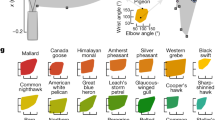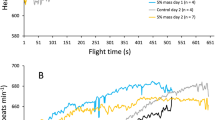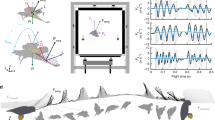Abstract
MEN have always wanted to fly by their own power, like birds. But man is five times heavier than the heaviest flying creature of this or any other epoch. This creates difficulties; for as birds increase in size, their wing area diminishes in relation to their weight, since geometrical configuration and density remain roughly the same. This effect can only be countered by a greater expenditure of mechanical power by the larger specimens. In fact, the power required for level flight increases as (weight)1.167 (Nonweiler, 1957, private communication).
This is a preview of subscription content, access via your institution
Access options
Subscribe to this journal
Receive 51 print issues and online access
$199.00 per year
only $3.90 per issue
Buy this article
- Purchase on Springer Link
- Instant access to full article PDF
Prices may be subject to local taxes which are calculated during checkout
Similar content being viewed by others
References
Brody, S., “Bioenergetics and Growth” (Reinhold, New York, 1945).
Dill, D. B., Edwards, H. T., and Talbot, J. H., J. Physiol., 77, 49 (1932).
Taylor, R. J. F., J. Physiol., 137, 210 (1957).
Nonweiler, T., J. Roy. Aeronaut. Soc., 62, 723 (1958).
Günther, B., and Guerra, E., Acta Physiologica Latinoamericana, 7, 95 (1957).
Author information
Authors and Affiliations
Rights and permissions
About this article
Cite this article
WILKIE, D. The Work Output of Animals: Flight by Birds and by Man-power. Nature 183, 1515–1516 (1959). https://doi.org/10.1038/1831515a0
Issue Date:
DOI: https://doi.org/10.1038/1831515a0
This article is cited by
-
Respiration, oxygen consumption and heart rate in some birds during rest and flight
Zeitschrift f�r Vergleichende Physiologie (1970)
-
Flight by Man-Power
Nature (1960)
Comments
By submitting a comment you agree to abide by our Terms and Community Guidelines. If you find something abusive or that does not comply with our terms or guidelines please flag it as inappropriate.



